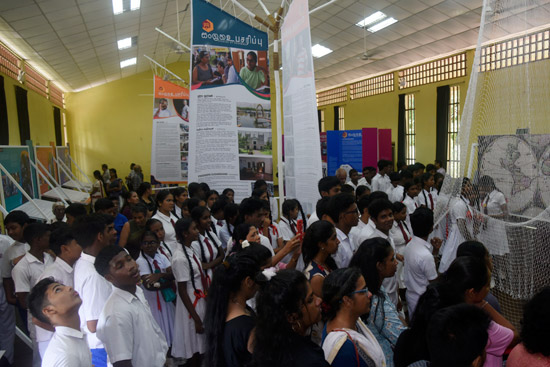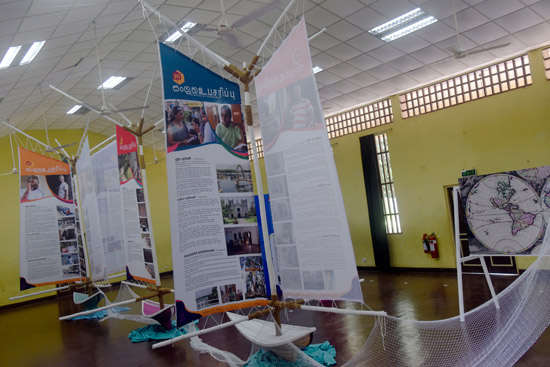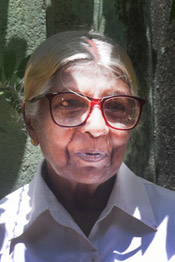What makes Negombo unique; this exhibition brings it to life
In a culturally diverse nation such as Sri Lanka, few places truly serve as living examples of how different communities can coexist peacefully even amidst the complexities of the country’s history like the coastal city of Negombo whose identity is a reflection of the intricate blend of languages, faiths, and traditions that create its distinct character.
This expression of coexistence was one that drove the Women and Media Collective to highlight Negombo these past three days with an exhibition that explored both historical and contemporary narratives of the dynamic city.

So much to discover: Schoolchildren at the exhibition on Thursday. Pix by Akila Jayewardena
‘Sangraha/Ubasarippu’, held at the Rukmani Devi Hall in Negombo from August 29-31, was a deep dive into the city’s vibrant tapestry, highlighting it as a model of resilience and harmony.
Informative visual panels, podcasts, music and narrations illustrated how its people have navigated through ethnic and religious tensions, conflicts, and violence, underscoring the enduring spirit of tolerance, mutual respect, and hospitality that are cornerstones of Negombo’s ethos.
The extensive research for this exhibition began two years ago but the Women and Media Collective had been collaborating with Negombo’s civil society groups long before. Negombo’s resilience was particularly evident in the aftermath of the 2019 Easter Sunday attacks, a time when the city’s civil society groups, religious leaders, and communities banded together to prevent retaliatory violence against the Muslim population.

“At that point, we were working with a group of Indonesian and Indian activists, and they were all concerned with the emergence of what the UN had been calling violent extremism, where even the Sri Lankan Easter attacks were termed violent extremism,” says Kumudini Samuel, WMC’s Director Programs – State, Politics, and Sexuality.
Through their research, which included several case studies, they discovered that while there was initial tension and fear among the Muslim community, life returned to normal within a month. Women spoke of their fears but also of the resilience that allowed them to move past this difficult period. “We realised that it was this really interesting inter-ethnic, inter-religious, intercultural mix in Negombo that was coming out everywhere, and a lot of it was manifested in food—in festivals and food.”

Malani Fernando
The city’s history reflects the influence of various peoples from the Arabs and Indians to the Chinese, Portuguese, Dutch and British. Each of these groups has left a mark on Negombo, particularly visible in its culinary traditions. For instance, dishes like Bibikkan, a traditional Goan sweet made with coconut, jaggery and semolina showcase the blending of different cultural influences over centuries, as does Ismoru beef curry which takes its name from the Dutch ‘smore’, or stew.
The exhibition also highlighted religious communities coming together in what can be termed an interfaith collaboration in the predominantly Catholic city to celebrate festivals, feasts, and other religious observances. While Vesak is observed by Buddhists, most dansal, which are traditionally held during this time are organised and run by Catholics. The Kiri Amma Dhane, performed to invoke the blessings of the Goddess Pattini, also known as Kannagi in Tamil, is held for fertility, to herald the birth of a child, or to heal illnesses like chickenpox, mumps, and measles. Some Catholics also host this almsgiving, incorporating Saint Sebastian into the Pattini ritual.
“Only women who have had children and whose children are still alive, and women who are not widowed before the age of 50, can be Kiri Ammas,” says Malani Fernando who serves as a Kiri Amma. She began participating in these ritals along with her mother who was also a Kiri Amma. “Nowadays these dhanes are also given for birthdays and marriages.”
Negombo is well-known for its sea and lagoon fishing, with most of the fishing community continuing to follow traditional fishing methods passed on for generations. The exhibits included black-and-white films from the 1950s that showcased the struggles and still contentious issues faced by the fishing communities. A highlight of the WMC’s ongoing work in Negombo is the commissioned film titled ‘Badiya’, meaning low tide, which tells the story of a prawn fisher who has supported her family for decades through the traditional method of night fishing with lamps. This film, alongside others, is part of the broader effort to document and preserve Negombo’s cultural heritage.
“When I first started doing this with WMC, I had no real idea about Negombo really other than it was near the airport, and I think that in the last two years, I’ve learnt so much. You kind of start hearing about other places in Sri Lanka and realise, what are different places compared to, say, my hometown?” says Menika Van Der Poorten, who was largely involved in curating the exhibition.
The work done by the WMC and the exhibition has caught the attention of local authorities, such as the District Secretariat, who have expressed interest in making the exhibition a permanent fixture in Negombo. There is a possibility that the exhibition, along with its online version, will be donated to a local institution, ensuring that this rich history continues to be accessible to future generations.
Searching for an ideal partner? Find your soul mate on Hitad.lk, Sri Lanka's favourite marriage proposals page. With Hitad.lk matrimonial advertisements you have access to thousands of ads from potential suitors who are looking for someone just like you.


